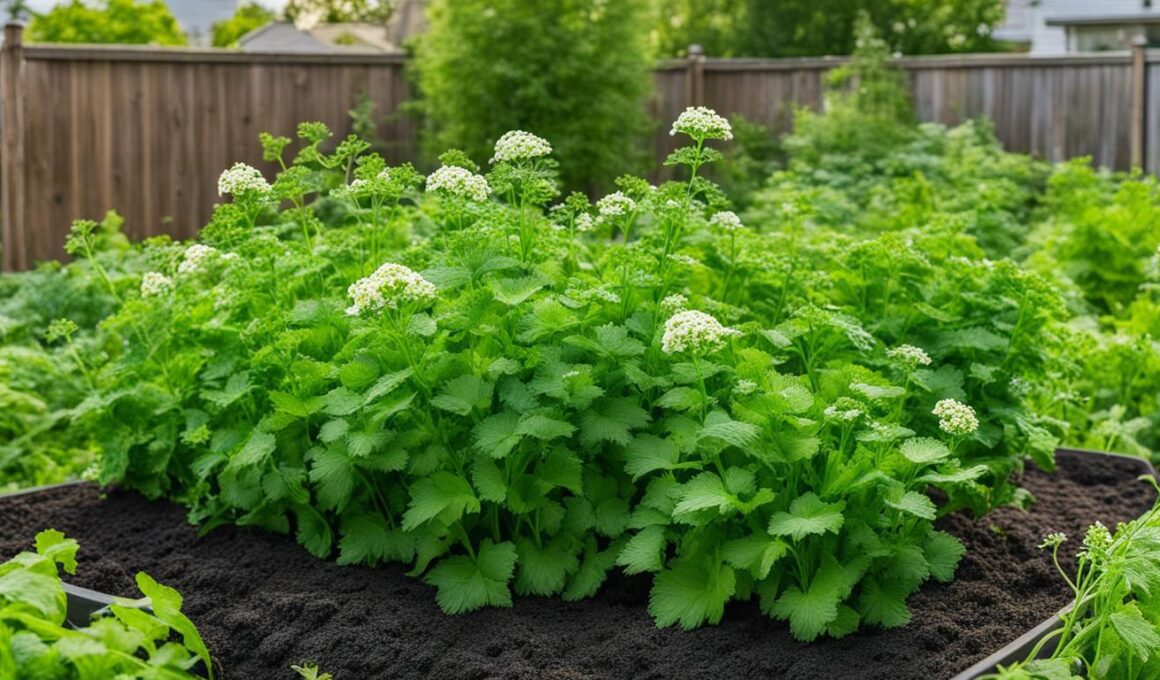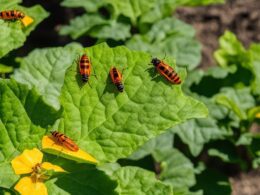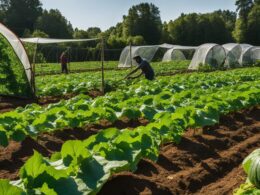Cilantro, also known as coriander, is a fast-growing herb that can be a delightful addition to your garden. Whether you want to enhance the flavors of your favorite dishes or simply enjoy the fresh aroma of this versatile plant, growing cilantro can be a rewarding experience. In this guide, we will explore everything you need to know about growing cilantro, from planting the seeds to harvesting the leaves and seeds.
Cilantro plants thrive in cool weather, making spring and fall the ideal seasons for growth. With its lacy leaves and clusters of white or pinkish flowers, cilantro adds beauty to your garden while also providing a flavorful ingredient for your culinary creations. Whether you have a dedicated herb bed, a corner of your vegetable garden, or even a container, cilantro can find a home and flourish with proper care.
To ensure optimal growth, cilantro requires well-drained soil enriched with organic matter. Regular watering and occasional feeding are necessary to encourage leaf production. When it comes to harvesting, it’s important to know the right time to pick the leaves and coriander seeds. Fresh cilantro leaves can be used in various dishes, and the seeds can be dried and stored for later use as a spice.
Post Summary:- Growing cilantro requires cool weather, such as spring and fall.
- Plant cilantro in well-drained soil enriched with organic matter.
- Water cilantro regularly and provide occasional feedings to promote leaf production.
- Harvest cilantro leaves when they are large enough to eat, but avoid taking more than one-third of the plant at a time.
- Store cilantro leaves by freezing or drying, and coriander seeds by drying and storing in an airtight container.
Choosing the Right Soil and Planting Cilantro
In order to successfully grow cilantro, it is important to choose the right soil and properly plant the seeds. Cilantro thrives in well-drained soil with a pH level ranging from 6.2 to 6.8. This ensures that the plant receives the necessary nutrients for healthy growth.
When selecting a spot in your garden for cilantro, choose an area that receives full sun or partial shade, especially in warmer climates. Cilantro can be planted in the spring after the last frost or in the fall. Prepare the soil by mixing in aged compost or organic matter, which helps improve the soil’s fertility and structure.
If you prefer growing cilantro in containers, it is recommended to use a premium potting mix that provides excellent drainage. This allows the cilantro plant to thrive in a confined space.
When it comes to planting cilantro seeds, sow them about 1 to 2 inches apart in rows. After planting, water the seeds regularly to ensure proper germination. Once the seedlings have sprouted, thin them to a spacing of 6 inches apart. This allows each plant to have enough space to grow and prevents overcrowding.
Recommended Soil pH Levels for Growing Cilantro
| Soil Type | pH Level |
|---|---|
| Loamy Soil | 6.2 – 6.8 |
| Sandy Soil | 6.2 – 6.8 |
| Clay Soil | 6.2 – 6.8 |
It is worth noting that cilantro can also be grown from starter plants, which can be convenient if you prefer not to start from seeds. By following these soil and planting guidelines, you can ensure that your cilantro plants have a strong foundation for growth and development.
Caring for Cilantro Plants
Proper care is essential to ensure healthy and thriving cilantro plants. By paying attention to watering, feeding, and pest control, you can enjoy a bountiful harvest of fresh cilantro leaves.
Watering Cilantro
Cilantro plants require consistent moisture to thrive. Water them regularly, especially during dry periods, to keep the soil evenly moist. Be cautious not to overwater, as it can lead to root rot. To determine if your cilantro plants need watering, check the top inch of soil – if it feels dry, it’s time to water.
Feeding Cilantro
To promote lush leaf production, feed your cilantro plants with a water-soluble plant food. Choose a balanced fertilizer, such as a 10-10-10 or 14-14-14 blend, and apply it according to the package instructions. Remember not to over-fertilize, as excessive nutrients can negatively impact the flavor and quality of the cilantro leaves.
Pest Control
Cilantro plants can be susceptible to aphids and whitefly. Monitor your plants regularly and take action if you notice signs of infestation. Insecticidal soap is an effective and environmentally friendly solution to control these pests. Follow the instructions on the soap bottle and apply it to the affected plants.
Remember to clean up any debris or spent plants from the garden bed to prevent the spread of pests and diseases. This will also help maintain optimal growing conditions for your cilantro plants.
By providing adequate water, nutrients, and pest control, you can ensure that your cilantro plants stay healthy and productive. With proper care, you’ll have a steady supply of fresh cilantro leaves to enhance the flavors of your favorite dishes.
| Pest | Symptoms | Treatment |
|---|---|---|
| Aphids | Small, soft-bodied insects clustered on the undersides of leaves | Apply insecticidal soap or a strong stream of water to dislodge aphids |
| Whitefly | Tiny, white insects that fly up when plants are disturbed | Use yellow sticky traps or apply insecticidal soap to control whitefly populations |
“Proper care and attention are key to growing healthy cilantro plants. By watering consistently, feeding appropriately, and addressing pest issues promptly, you can enjoy a thriving cilantro crop.” – Gardening Expert
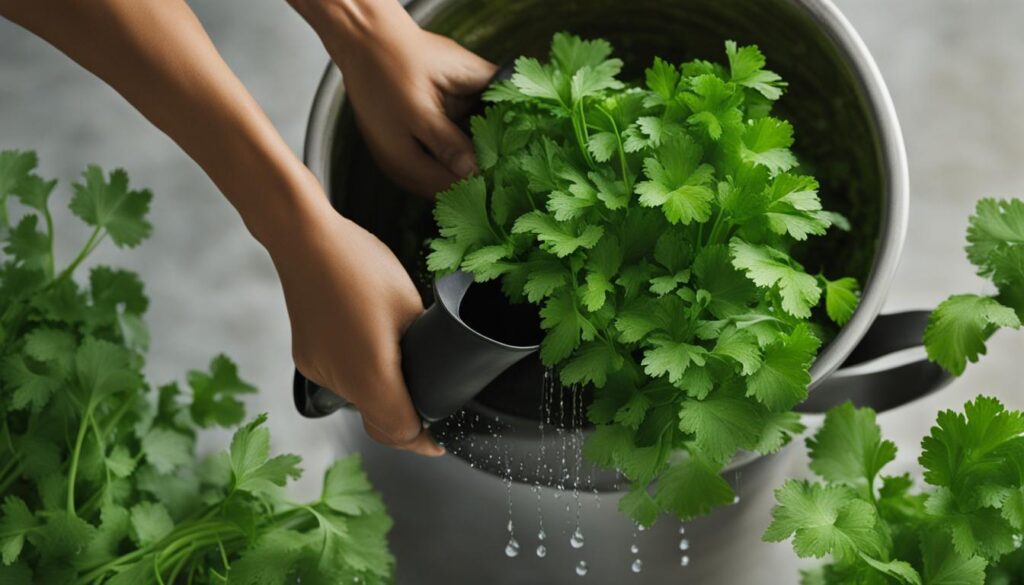
Harvesting Cilantro Leaves and Seeds
Harvesting cilantro at the right time is crucial to ensure the best flavor and quality of the leaves. The leaves can be harvested once they reach a size of 6 to 12 inches long. Using a clean pair of pruning shears or scissors, cut the leafy stems near the ground level. It’s important to avoid harvesting more than one-third of the leaves at a time to allow the plant to continue growing.
Cilantro leaves are best used fresh, as they wilt and lose their flavor quickly. Incorporate them into various dishes such as salsas, salads, soups, and curries to add a refreshing and citrusy taste. Chop the leaves just before using them to maintain their vibrant green color and aromatic flavor.
To harvest coriander seeds, allow the cilantro plant to flower. Once the flowers have bloomed and faded, seed heads will develop. Let the seed heads dry on the plant until they turn brown. Carefully clip off the seed heads and place them upside down in a paper bag to catch any loose seeds. After a few days, the seeds will dry further and split inside the bag. Store the coriander seeds in an airtight container, and use them to add a warm and citrusy flavor to spice blends, pickles, and other culinary creations.
Tips for Harvesting Cilantro:
- Harvest cilantro leaves when they reach a size of 6 to 12 inches long.
- Use clean shears or scissors to cut the leafy stems near the ground level.
- Avoid harvesting more than one-third of the leaves at a time for continued growth.
- Use cilantro leaves fresh for the best flavor and color.
- Harvest coriander seeds by allowing the plant to flower and dry the seed heads.
- Store coriander seeds in an airtight container for later use in spice mixes and more.
Harvesting cilantro is a rewarding process that allows you to enjoy the fresh and vibrant flavors of this versatile herb. By following these tips and techniques, you can make the most of your cilantro plants and enhance your culinary creations with its unique taste.
Cilantro Harvesting Comparison Table:
| Aspect | Harvest Time | Usage |
|---|---|---|
| Cilantro Leaves | 6 to 12 inches long | Used fresh in various dishes |
| Coriander Seeds | When seed heads turn brown and dry | Used as a spice in cooking |
Troubleshooting Common Issues with Cilantro
Growing cilantro can be a rewarding experience, but like any plant, it can encounter its fair share of problems. Here are some common issues you may come across when growing cilantro and how to troubleshoot them:
Pests
Cilantro plants can be susceptible to pests such as aphids and whitefly. These tiny insects can infest the leaves and stems, causing damage and hindering growth. To control these pests, you can make a homemade insecticidal soap by mixing 1 tablespoon of liquid dish soap with 1 quart of water. Spray the mixture onto the affected plants, making sure to cover all surfaces. Repeat every few days until the pest infestation is under control.
Diseases
Cilantro may also be prone to diseases such as fungal infections, wilt, and mildew. These can be caused by excessive moisture, poor air circulation, or contaminated soil. To prevent these diseases, make sure to provide adequate spacing between plants to allow for good airflow. Avoid overwatering and water the plants at the base instead of overhead. If you notice any signs of disease, such as yellowing leaves or powdery growth, remove the affected plants and dispose of them to prevent further spread.
Other Problems
In addition to pests and diseases, cilantro may face other problems. For example, if you live in a hot climate, cilantro may bolt or go to seed quickly. To overcome this issue, plant cilantro in the cooler months or provide shade during the hottest parts of the day. If your cilantro plants are not growing vigorously, they may require additional nutrients. Consider using a balanced organic fertilizer to give your plants a boost. Remember to follow the package instructions and avoid over-fertilizing, as this can lead to nutrient burn.
Being aware of these common issues and taking the necessary steps to address them can help ensure the success of your cilantro plants. By troubleshooting and providing the right care, you can enjoy a bountiful harvest of fresh and flavorful cilantro leaves.
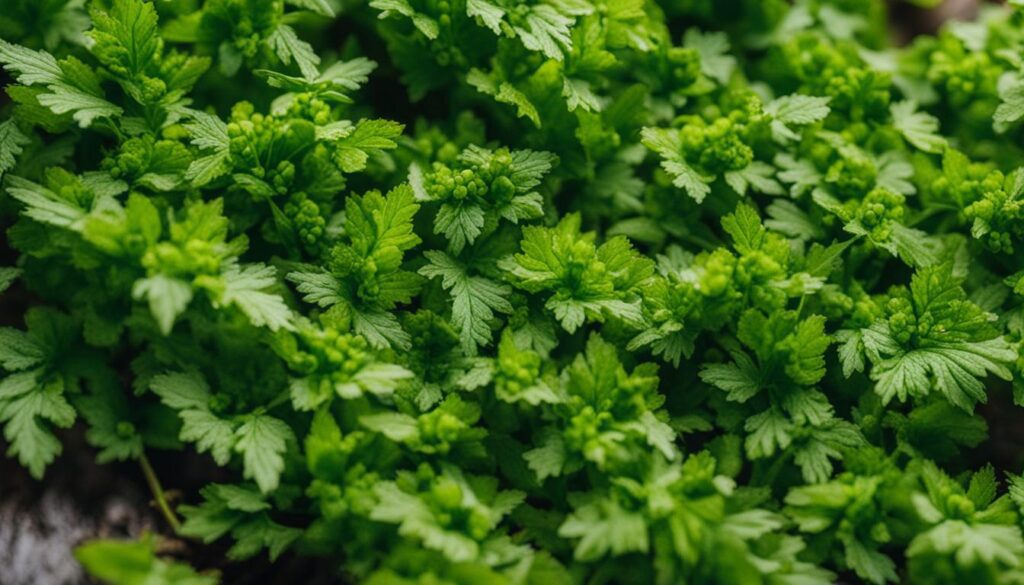
Using and Storing Cilantro
Once you’ve successfully grown your cilantro, it’s time to start using it in your favorite recipes. The fresh and vibrant flavor of cilantro can elevate any dish, whether it’s a salad, salsa, or curry. Cilantro pairs well with a variety of ingredients, including mint, cumin, garlic, and other herbs and spices. It’s best to add cilantro leaves at the last minute to maximize their flavor.
While cilantro is best used fresh, there are storage methods that can help you enjoy its flavors for a longer period. One popular method is freezing cilantro leaves in cubes of water or oil. Simply chop the cilantro leaves and place them in an ice cube tray filled with water or oil. Once frozen, transfer the cilantro cubes to a freezer bag and store them in the freezer. This way, you can easily add cilantro to your dishes whenever you need it.
Another option for storing cilantro is drying it. However, keep in mind that drying cilantro can result in a loss of flavor. To dry cilantro, tie the stems together and hang them upside down in a well-ventilated area. Once completely dry, remove the leaves from the stems and store them in an airtight container.
Common Methods of Using and Storing Cilantro
| Method | Description |
|---|---|
| Using Fresh Cilantro | Chop the fresh cilantro leaves and add them to dishes for a burst of flavor. |
| Freezing Cilantro | Chop the cilantro leaves and freeze them in cubes of water or oil for long-term storage. |
| Drying Cilantro | Tie the cilantro stems together, hang them upside down in a well-ventilated area to dry, and store the dried leaves in an airtight container. |
Whether you choose to use cilantro fresh or store it for later, this versatile herb can add a unique taste to your culinary creations. Experiment with different cilantro recipes and explore the endless possibilities of this flavorful herb in your cooking.
Can I Use the Same Techniques to Grow Kale as I Do for Growing Cilantro?
When it comes to growing kale in your garden, the techniques may differ from those used for growing cilantro. Kale requires cooler temperatures and well-drained soil, while cilantro prefers warmer conditions and regular watering. Tailoring your gardening approach accordingly will ensure successful growth of both these versatile and delicious greens.
Conclusion
Growing cilantro can be a fulfilling and flavorful addition to your garden. By following the tips and techniques outlined in this guide, you can cultivate a thriving cilantro plant and enjoy its fresh leaves throughout the year.
Remember to choose the right soil and location for planting cilantro, ensuring it receives adequate sunlight and water. Proper care, including regular watering and occasional feeding, will help promote lush leaf production.
Harvesting cilantro leaves and coriander seeds at the right time will ensure their maximum flavor and quality. And when it comes to using and storing cilantro, fresh is always best. Although cilantro leaves do not dry well, freezing or preserving them in oil can be a suitable option.
So, whether you’re a beginner or experienced gardener, cilantro offers a versatile and aromatic addition to your culinary endeavors. Enjoy the process of growing cilantro and savor the vibrant flavors it adds to your favorite dishes!
Can I Grow Cilantro and Basil Together in the Same Garden?
Yes, growing basil and marigolds together is beneficial for both plants. The pungent aroma of basil can repel pests that may attack cilantro, while marigolds can also protect the basil from harmful insects. Additionally, these plants have similar watering and sunlight needs, making them great companions in the garden.
FAQ
When is the best time to plant cilantro?
Cilantro can be planted in the spring after the last frost or in the fall.
Can cilantro be grown in containers?
Yes, cilantro can be grown in containers. Use a premium potting mix for best results.
How often should cilantro plants be watered?
Cilantro plants require regular watering, especially during dry periods. However, be careful not to overwater to prevent root rot.
What pests can affect cilantro plants?
Cilantro plants can be susceptible to aphids and whitefly. These pests can be controlled with insecticidal soap.
How should cilantro leaves be harvested?
Cilantro leaves can be harvested once they are large enough to eat, usually around 6 to 12 inches long. Cut the leafy stems near the ground level, but avoid harvesting more than one-third of the leaves at a time.
Can cilantro be stored for later use?
Yes, cilantro leaves can be frozen in cubes of water or oil. Drying cilantro is also possible, although it may result in a loss of flavor. Coriander seeds can be stored in a cool and dry place for later use as a spice.
What are common issues that can arise when growing cilantro?
Cilantro plants may encounter pests such as aphids and whitefly. Wilt and mildew can also be problems. Cleaning up debris and spent plants can help prevent these issues.
How should cilantro be used in cooking?
Cilantro leaves can be added to various dishes for flavor. It pairs well with mint, cumin, garlic, and other herbs and spices. Use it fresh at the last minute for maximum flavor.
Can cilantro be grown indoors?
Yes, cilantro can be grown indoors in a hydroponic system for a longer growing season.
How can cilantro self-sow?
Cilantro plants can produce seeds that fall to the ground and grow into new plants.





